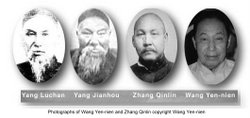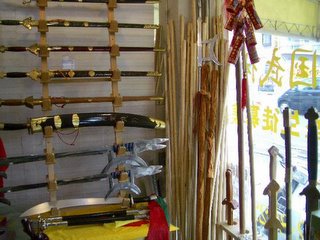
Taijiquan (or, in Wade Giles romanization, T'ai-Chi Ch'uan), has its roots in traditions that go back thousands of years. One version of its beginning is that Zhang Sanfeng, a Taoist monk, was watching a crane and a snake battle and was struck by the way that they used deception and body movements to evade the attacks of each other. Finally exhausted from the even contest the two creatures left. Sanfeng, though, was left with thoughts that led to development of the early basics of taijiquan .
Taiji was developed and refined for centuries by the Chen Family of Chen village, where many masters were produced. In the early 19th century, a young man named Yang Luchan, entered the Chen village and attained, through hard study and secretive methods, the essential teachings of what had been, until then, a Chen village art form. There are a number of versions of who Yang Luchan was and how this attainment of knowledge came about (see, for instance, "Yang Family Secret Transmissions" by Douglas Wile) and the Yangjia Michuan heritage has its own. What is clear, though, is that Yang Luchan left the Chen Village and went on to create the Yang Family Taiji Tradition. He did this by combining his deep knowledge of the Chen tradition with the ancient teachings of, among others, Zhang Sanfeng.
But Yang Luchan's martial instincts and physical qualities were also of the highest caliber - soon be became known as "Yang the Invincible." He traveled across China to demonstrate his skills and met great success wherever he went. It is with this great success, and the attention that it brought Yang Luchan, that the story of Yangjia Michuan Taijiquan, or "the Hidden Tradition", begins. The Manchu Emperors, who ruled China at this time, heard of Yang's exceptional ability and determined that he would teach his skills to the Manchu warriors. But Yang Luchan did not teach them the form that he developed and used to such great success. He taught them a modified form and, to ensure the safety of his own family, taught them the modified form as well. There are many takes on the veracity of this event, and on the rationale. This is the story that Zhang Qinlin, who learned Michuan Taijiquan from Yang Jianhou, who learned it from his father Yang Luchan, told to Wang Yen-nien as he taught the form and all of it's essential elements to him.
The fact that Yang Luchan taught a "public form" and only taught his original form to a few people does not mean that one form is better than another. It simply means that there is an older form that was almost lost to the Martial Arts world but is now being taught by many schools and teachers. When Yang Luchan looked at his family for a disciple to pass the Yangjia Michuan form to he chose his son Yang Jianhou, who had the temperament and dedication he felt necessary to learn this system and to preserve it. It was many years before Yang Jianhou found the right student. Zhang Qinlin was a student of Yang Chengfu and demonstrated both outstanding dedication and great Martial capabilities. Jianhou tested him and, finding him up to his standards, taught him in secret between midnight and sunrise. Zhang Qinlin became a great Martial Arts master and demonstrated his skills widely in China during the 1920's, 1930's and 1940's.
With the help of his Taoist teacher, Zhang Maolin, Wang Yen-nien, a Colonel in the Nationalist army and an accomplished martial artist, met Zhang Qinlin in 1945 and, after being accepted as his vowed student, received the full transmission of Yangjia Michuan Taijiquan in four years of day and night practice with Zhang Qinlin. Wang Yen-nien has taught this form, as Zhang Qinlin's only surviving student to have learned it, since 1950. Teaching at the Grand Hotel in Taipeii, he has helped to found numerous associations for the development of taijiquan. These include the National T'ai Chi Ch'uan Association, the Taipei City Taijiquan Association, The European College for Yangjia Michuan Taijiquan Teachers, and The AMICALE (a confederation of associations teaching the Yang Family Hidden Tradition of Taijiquan). He served as President of the National T'ai Chi Ch'uan Association and, when he stepped down in 1989 was named Honorary Chief Instructor and President for Life. This vigorous and complete martial arts system, which includes basic exercises, the 13 postures (an introductory form), a one hour long form (127 postures), push hands, push hand exercises, and numerous weapons forms, as well as a deep foundation in neigong breathing practice, is taught world wide.
Credit for this article goes to Tom Campbell and aymt.org



